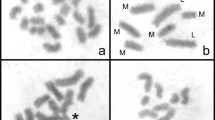Abstract
The endemic Australian grasshopper Heteropternis obscurella shows considerable variation in respect of both chromosome structure and chromosome behaviour. The structural differences depend upon different patterns of heterochromatin distribution as revealed by C-banding. These involve differences between populations in respect of polytypic variation in the size of paracentromeric C-bands and differences within populations in respect of polymorphisms both for terminal blocks of heterochromatin in autosomes 3 to 8 and a large proximal block of heterochromatin in autosome 7. The behavioural differences stem in part from genotypically determined variation in the chiasma distribution pattern which is markedly localised in a majority of populations but more randomly distributed in populations from the south of Western Australia. Behavioural differences also arise as secondary consequences of the presence of those heterochromatic blocks which occur as polymorphisms. The distal blocks on autosomes 5, 6, 7 and 8 lead to a redistribution of chiasmata to more proximal sites while the proximal block on 7 leads to the virtual abolition of chiasma formation in that bivalent and its replacement by a non-chiasmate mechanism of segregation. This depends upon a persistent proximal heterochromatic association between the pairing partners. The presence of distal C-blocks on bivalents 3 to 8 gives rise to persistent pseudomultiples, formed as a result of heterochromatic associations between these blocks. Such pseudomultiples involve any two or three of these six bivalents, provided they carry distal blocks, and their frequency rises dramatically in the presence of the proximal heterochromatic block on chromosome 7.
Similar content being viewed by others
References
Belling, J.: Chiasmas in flowering plants. Univ. Calif. Publ. Bot. 16, 311–338 (1931)
Cassagnau, P.: Polyploidie, polyténie, oligoténie dans les glandes salivaire de Contarina pirivora (Ril.) Kieff (Diptères Cecidomyidae). C.R. Acad. Sci. (Paris) Ser D 271, 223–225 (1970)
Cooper, K.W.: Meiotic conjunctive elements not involving chiasmata. P.N.A.S. 52, 1248–1255 (1964)
Darlington, C.D.: Recent advances in cytology. London: Churchill 1932
Drets, M.E., Stoll, M.: C-banding and non-homologous associations in Gryllus argentinus. Chromosoma (Berl.) 48, 367–390 (1974)
Gropp, A., Citoler, P., Geisler, M.: Karyotypvariation und Heterochromatinmuster bei Igeln (Erinaceus und Hemiechinus). Chromosoma (Berl.) 27, 228–307 (1969)
John, B.: The cytogenetic systems of grasshoppers and locusts II. The origin and evolution of supernumerary segments. Chromosoma (Berl.) 44, 123–146 (1973)
John, B.: Heterochromatin variation in natural populations. Chromosomes Today 7, 128–137 (1981)
John, B., Claridge, M.F.: Chromosome variation in British populations of Oncopsis (Hemiptera: Cicadellidae). Chromosoma (Berl.) 46, 77–89 (1974)
John, B., King, M.: Heterochromatin variation in Cryptobothrus chrysophorus I. Chromosome differentiation in natural populations. Chromosoma (Berl.) 64, 219–239 (1977)
John, B., King, M.: Heterochromatin variation in Cryptobothrus chrysophorus III. Synthetic hybrids. Chromosoma (Berl.) 78, 165–186 (1980)
John, B., Lewis, K.R.: Genetic speciation in Eyprepocnemis plorans. Chromosoma (Berl.) 16, 308–344 (1965)
Jones, G.H.: The control of chiasma distribution in rye. Chromosoma (Berl.) 22, 69–90 (1967)
Kanda, N., Kato, H.: Analysis of crossing over in mouse meiotic cells by BrdU labelling technique. Chromosoma (Berl.) 78, 113–121 (1980)
King, M., John, B.: Regularities and restrictions govening C-band variation in acridoid grasshoppers. Chromosoma (Berl.) 76, 123–150 (1980)
Mancino, G., Ragghianti, M., Bucci-Innocenti, S.: Experimental hybridisation within the genus Triturus (Urodela: Salamandridae) I. Spermatogenesis of F1 species hybrids, Triturus cristatuscarnifex ♀ x T. vulgaris meridionalis ♂. Chromosoma (Berl.) 69, 27–46 (1978)
Miklos, G.L.G., Nankivell, R.N.: Telomeric satellite DNA functions in regulating recombination. Chromosoma (Berl.) 56, 143–167 (1976)
Moses, M.L.: The synaptonemal complex and meiosis. In: Human molecular cytogenetics (R.S. Sparkes, D.E. Comings and C.F. Fox, eds.) pp 101–125. New York: Academic Press 1977
Nankivell, R.N.: A terminal association of two pericentric inversions in first metaphase cells of the Australian grasshopper Austroicetes interioris (Acrididae). Chromosoma (Berl.) 22, 42–68 (1967)
Natarajan, A.T., Gropp, A.: The meiotic behaviour of autosomal heterochromatic segments in hedgehogs. Chromosoma (Berl.) 35, 143–152 (1971)
Nur, U.: Meiotic behaviour of an unequal bivalent in the grasshopper Calliptamus palaestinensis (Bdhr.). Chromosoma (Berl.) 12, 272–279 (1961)
Polani, P.E., Crolla, J.A., Seller, M.J., Moir, F.: Meiotic crossing over exchange in the female mouse visualised by BUdR substitution. Nature (Lond.) 278, 348–349 (1979)
Shaw, D.D., Wilkinson, P.: “Homologies” between non-homologous chromosomes in the grasshopper Caledia captiva. Chromosoma (Berl.) 68, 241–259 (1978)
Southern, D.I.: Pseudo-multiple formation as a consequence of prolonged non-homologous chromosome association in Metrioptera brachyptera. Chromosoma (Berl.) 21, 272–284 (1967)
Tease, C., Jones, G.H.: Analysis of exchanges in differentially stained meiotic chromosomes of Locusta migratoria after BrdU substitution and EPG staining. I. Crossover exchanges in monochiasmate bivalents. Chromosoma (Berl.) 69, 163–178 (1978)
Therman, E., Kuhn, E.M.: Cytological demonstration of mitotic crossing-over in man. Cytogenet. Cell Genet. 17, 254–267 (1967)
Webb, G.C.: Chromosome organisation in the Australian plague locust, Chortoicetes terminifera. I. Banding relationship of the normal and supernumerary chromosomes. Chromosoma (Berl.) 55, 229–246 (1976)
White, M.J.D.: Cytogenetics of the grasshopper Moraba scurra. I. Meiosis of interracial and interpopulation hybrids. Aust. J. Zool. 5, 285–304 (1957)
White, M.J.D.: The role of chromosome translocations in urodele evolution and speciation in the light of work on grasshoppers. Amer. Naturalist 95, 315–321 (1961)
White, M.J.D.: Chromosomal rearrangements and speciation in animals. Ann. Rev. Genet. 3, 75–98 (1969) Received November 24, 1981 from B. John
Author information
Authors and Affiliations
Rights and permissions
About this article
Cite this article
John, B., King, M. Meiotic effects of supernumerary heterochromatin in Heteropternis obscurella . Chromosoma 85, 39–65 (1982). https://doi.org/10.1007/BF00344593
Received:
Issue Date:
DOI: https://doi.org/10.1007/BF00344593




